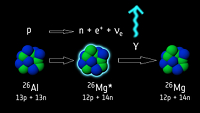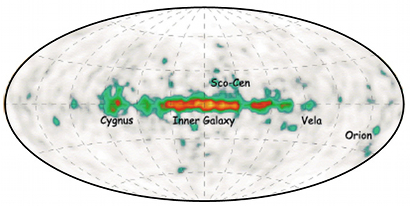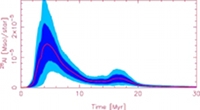INTEGRAL helps unravel the tumultuous recent history of the solar neighbourhood
26 November 2010
Just like archaeologists, who rely on radioactive carbon to date the organic remains from past epochs, astronomers have exploited the radioactive decay of an isotope of aluminium to estimate the age of stars in the nearby Scorpius-Centaurus association, the closest group of young and massive stars to the Sun. The new observations, performed in gamma rays by ESA's INTEGRAL observatory, provide evidence for recent ejections of matter from massive stars that took place only a few million years ago in our cosmic neighbourhood.A common technique used in archaeology to establish the age of fossils and other organic samples from the past consists of measuring how much of a particular isotope of carbon, namely carbon-14 (14C), they contain. This radioactive isotope decays into the element nitrogen on a time scale of a few thousand years, hence the amount of it remaining in these ancient fossils is a strong indicator of the epoch from which they date. An analogous method, based on the radioactive decay of an unstable isotope of aluminium, has been recently exploited by astronomers to probe and assess the age of the Scorpius-Centaurus association, the closest group of very young and massive stars. Stellar age estimates can be then used to investigate how nearby massive stars have shaped our local region of the Milky Way.
 |
|
The radioactive decay process of 26Al. Credit: ESA |
"Conveniently for astronomers, the decay of 26Al involves a similar time scale to that spanned by the life time of massive stars, which is of the order of a few million years," explains Roland Diehl from the Max-Planck Institute for Extraterrestrial Physics in Germany, who led a recent study targeting the gamma-ray emission from this isotope in the Scorpius-Centaurus association. "As its decay time is 'just right', measuring the abundance of 26Al is an excellent tool to trace the presence of young and massive stars, and it allows us to directly estimate their age," he adds.
 |
|
COMPTEL all-sky image of 26Al gamma rays. |
Earlier observations, conducted in the 1990s with the COMPTEL instrument on NASA's Compton Gamma-Ray Observatory, revealed for the first time the emission of 26Al across the entire sky. Subsequent data collected by ESA's INTEGRAL mission confirmed these results, probing the global properties of this isotope throughout the plane of the Milky Way thanks to INTEGRAL's improved spectral resolution.
"At the characteristic energy of the 26Al line, INTEGRAL has a spectral resolution over 60 times better than COMPTEL's, enabling us to study the intensity and shape of this line across the Galaxy in much greater detail," comments Chris Winkler, INTEGRAL Project Scientist. "The data, gathered over five years, are so deep that it is now possible to isolate the contribution due to an individual, nearby stellar complex from the overall galactic 26Al emission," adds Winkler.
 |
|
The evolution of the abundance of 26Al in a stellar group. |
Via stellar winds and supernova explosions, the stars in the Scorpius-Centaurus association are currently enriching the surrounding interstellar medium with heavy elements, including aluminium, and from the shape of the emission line of 26Al it is possible to constrain the kinematics of such ejecta. "By investigating the details of these outflows of radioactive gas, streaming at velocities of about 100 km/s towards the Sun, we are starting to unravel the recent history of massive star formation in the Solar System's vicinity and its implications on our own cosmic environment," comments Diehl.
The new INTEGRAL data also allowed the astronomers to refine the estimate of the total content of 26Al in the Milky Way, which is lower by about 20 per cent than previous estimates. This is a critical step that is required to validate our understanding of the star formation and nucleosynthesis processes in our Galaxy and to predict the expected rate of supernova explosions.
Notes for editors:The study is based on observations performed with the gamma-ray spectrometer, SPI, on board INTEGRAL. The data have been gathered in the energy range between 1785–1826 keV, which embraces the 26Al line energy at 1808.63 keV, in bins of 0.5 keV. At this energy, the spectral resolution of SPI is 3 keV; the line positioning precision of 0.5 keV corresponds to a velocity resolution of about 75 km/s.
The data have been collected during about five years of INTEGRAL observations, between February 2003 and November 2007, with a total exposure of 61 million seconds, corresponding to almost 17,000 hours.
The half-life of a radioactive substance is the time required for half the nuclei to decay; for 26Al this quantity is ~700,000 years. Another quantity used to measure the time scale of radioactive decay is the exponential lifetime, or the time required for the number of nuclei to decrease by a factor of e (Euler's number); the exponential lifetime of 26Al is ~1 million years. As a comparison, the half-life of 14C , used for archaeological dating, is ~5700 years, and the exponential lifetime is ~8200 years.
Contacts
Roland Diehl
Max-Planck Institute for Extraterrestrial Physics
Garching, Germany
Phone: +49-89-30000-3850
Email: rod mpe.mpg.de
mpe.mpg.de
Thomas Preibisch
University Observatory Munich, Germany
Phone: +49-89-2180-6016
Email: preibisch usm.uni-muenchen.de
usm.uni-muenchen.de
Chris Winkler
INTEGRAL Project Scientist
Research and Scientific Support Department
Directorate of Science and Robotic Exploration
ESA, The Netherlands
Phone: +31-71-565-3591
Email: cwinkler rssd.esa.int
rssd.esa.int

